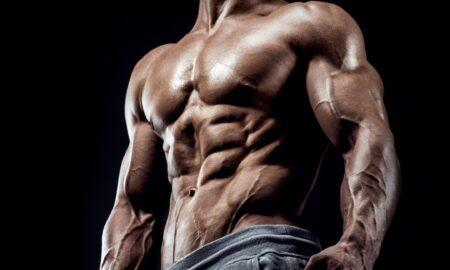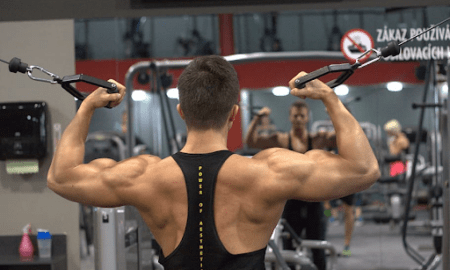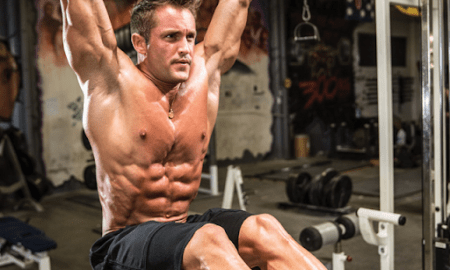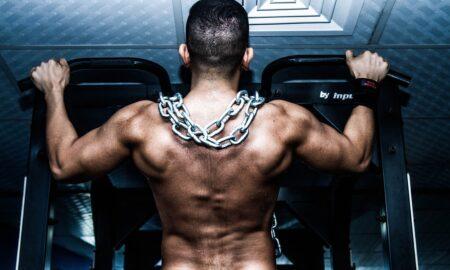 At Johns Hopkins I could always tell when it was getting close to spring break. The situp stations would be busy all day. The quest for a six-pack was under way in earnest for both men and women. Knowing that their bodies would soon be under full scrutiny on a beach in Florida or Texas was sufficient motivation for attacking their abs.
At Johns Hopkins I could always tell when it was getting close to spring break. The situp stations would be busy all day. The quest for a six-pack was under way in earnest for both men and women. Knowing that their bodies would soon be under full scrutiny on a beach in Florida or Texas was sufficient motivation for attacking their abs.
When I trained at commercial gyms across the country, I could spot the men who were having an illicit affair or who were recently divorced. Serious ab work was suddenly an integral part of their workouts.
Why abs? Simple. If you want to appear physically fit and healthy for the opposite sex—or even your own—you have to have a toned midsection. Beer guts and love handles just don’t cut it. To most, the condition of the abdominals is the best barometer of a person’s overall fitness. A person with big arms and a big chest may indeed be strong, but if his middle is flabby, he’s not fit.
That’s why I’m not that impressed with the current crop of bodybuilders. They lack the eye-popping abs that were standard for the top men when I first got involved in weight training. There was even a time when the best abs got special recognition at the Mr. America contests. I always thought that was a great idea, enabling some of the smaller athletes to gain rewards for their hard work on some bodypart.
As most older readers know, Zabo Koszewski dominated the Best Abs category at major contests for many years. He had no peer, and that was long before steroids and specialized ab machines. Zabo and others like him achieved extraordinary ab development the old-fashioned way—lots of hard work on the basics. I never verified it with him, but the story goes that Zabo started doing situps to help repair damage from a double hernia and ended up doing as many as a thousand a day.
Which brings me to a salient point about the abs—they can handle a great deal of work. Once the base is solid, abs can be exercised for extended periods and several times during the day. That’s why I’m a bit doubtful about the programs advertised in the media that promise startling results in just a few minutes a day, three times a week. A person who’s already trim may get noticeable results with that approach, but anybody carrying excess weight around the waist is going to have to do a lot more than that. A whole lot more.
If it were as easy to achieve a six-pack as the marketers profess, then the majority of those who train would have them. Of course, we know that’s not the case, not by a long shot. To shed unwanted pounds and transform your abs into distinct rows of muscle takes time and concentrated effort. If the spirit is willing, then the flesh will respond, for the abs can handle the work and respond favorably.
I witnessed an example of extreme ab training when I helped a gym startup in Edgewood, Maryland. Back then men and women trained separately, so the facility contained two workout areas. Donna and I were in charge of instructing the new female members. I handled the primary exercises, and she took care of the rest, including ab exercises. Because she felt that doing an exercise with a person helped motivation, she worked right alongside members she taught to do situps and leg raises. I agreed with her, although I had no idea how she did those two exercises all day and into the night. She told me she figured that on one busy Monday she did more than 1,500 situps and almost as many leg raises. Needless to say, she could have done her laundry on her abs, and she was an inspiration to the members to put in more effort for their midsections.
One of the reasons you don’t see very many examples of fit abs is the quick-fix mentality that dominates our present culture. Whatever we want, we want now. Forget lay-a-way; put it on the credit card. Need to drop some weight? Take a pill—faster and a hell of a lot easier than dieting and exercising. That attitude is what prompts the marketing machines and fitness programs to promise an easy, fast, painless solution to getting rid of pounds around the middle.
I’m not saying that all of those programs and machines aren’t effective, because some of them can be if they’re worked consistently and vigorously enough. To contend that dramatic results can be achieved with a minimum of effort only a few days a week, however, is totally false. The masses always embrace comfortable solutions to a problem over difficult ones, but when your goal is to burn off fat and build muscle in its place, you must take exactly the opposite course: Seek out a demanding routine and attack.
Creating a six-pack requires much more than just exercising your abs rigorously and consistently. Quite often you have to alter your eating habits drastically and become more active. You may be able to build a nice set of abdominals through hard work, but if you’re still carrying excess weight, nobody—including you—will be able to see that newly formed muscle.
I don’t plan on going into depth on diet. Excellent articles dealing with the subject appear in IRON MAN each month—especially the ones written by Jerry Brainum, which provide valuable insight into how to lose weight while maintaining your strength. Nevertheless, here are a few tips that might help you get started on shedding some unwanted pounds.
• Eliminate all junk foods and others that only provide empty calories.
• Eat fewer carbs and build your diet around protein.
• Take supplements to ensure that you’re getting all the vital vitamins and minerals as you lower your calorie intake.
• Cut way back on sugar and products high in sugar content, which includes many beverages.
At the same time increase your activity level. It doesn’t have to be an organized class or regimen. Just start walking a bit farther or participating in some athletic activity. Here’s a truism that’s been around for a long time: If you burn more calories than you absorb, you’re going to lose weight. If you eat more than you burn off, you’ll gain. Every little bit counts. Find something you enjoy, and do it on your nontraining days. A friend of mine loves to garden and work on his lawn, and every summer he drops a dozen pounds doing just that.
For older trainees the quest for a six-pack is even tougher than it is for the younger set, and it has nothing to do with eating habits or how active they are. It all comes down to Mother Nature. Until the age of 40, men produce an adequate amount of testosterone and women estrogen. That helps control fat allocation, keeping it away from the abdomen, and when the hormones begin to decline, the fat starts flowing from the legs, hips and arms to the abs, accumulating deep inside the belly.
To add insult to injury, once you hit 30, your lean muscle mass decreases by about a pound a year. Those who aren’t active enough discover that muscle gets quickly replaced by fat. You can’t change the facts, but it’s not a lost cause. Two studies that analyzed the effects of strength training in adults between 50 and 70 years old showed a 10 to 15 percent decrease in belly fat despite no loss of bodyweight.
A study published in the Journal of the American Medical Association in 2003 explained that women who exercised 30 to 45 minutes a day, five days a week, for a year cut their belly fat by 3 to 6 percent. The more exercise they did, the more belly fat they lost.
While we can’t do a hell of a lot about getting older, we can stay active and, if we follow a sensible eating plan, keep from becoming chubby with a protruding gut. Hey, I like sweets and high-carb foods, too, and can’t say I really enjoy pounding away on my abs six days a week. After a trip to the supermarket or mall, though, I come home determined that I won’t permit myself to get so lazy that I look like 90 percent of the men I see waddling around like whales out of water. Laziness is what it’s all about in the final analysis, laziness and lack of discipline, which in a way are the same thing.
Battling the bulge has much greater implications than mere vanity. Accumulated belly fat can cause serious health problems. Research has associated it with increased risk of heart disease, diabetes and some forms of cancer. Two types of fat have to be reckoned with: 1) the subcutaneous kind, which that lies just under the skin, and 2) visceral fat, which develops deep inside the abdomen and is the more troublesome of the two. The underlying fat hampers the liver’s processing of cholesterol and insulin, as well as the normal functioning of other tissues and systems. A study conducted by the VU Medical Center in Amsterdam found a link between accumulated visceral fat and capillary inflammation, which contributes to heart disease, as well as insulin resistance, a precursor of diabetes.
So if you’ve let yourself pack on too many extra pounds around your middle, it’s time to get rid of it. Change your eating habits, get in motion, and begin a systematic routine for your abs. The good news is that you can alter the process, and there are plenty of ab exercises to choose from—many that you can do at home without any sort of equipment.
My favorite has always been bent-knee situps. You can do them lying flat on the floor with your toes hooked under the edge of a couch, but I prefer doing them on a slight incline. Am I the only one who’s noticed that situp boards have vanished from gyms and fitness facilities? They were always an essential part of every gym until the supposedly more effective specialized pieces came along. Situp boards are now considered obsolete. In a pig’s eye. Give me a situp board with a ladder so that the angle can be changed and a willing subject, and I can convert his flabby middle to a six-pack. One reason I like an adjustable situp station is that I can start someone on the lowest rung and then slowly elevate the incline so that he or she has to continuously work harder. Yet it’s not an abrupt change.
I’m very aware of the criticism about situps, that they involve the hips and legs too much. I don’t consider that a bad thing. It’s the reason I have athletes do situps as part of their warmup. I want the other groups to be part of the act, and, regardless of whether the hips and legs are helping out, when you move your situps from 100 reps to 200, your abs are carrying the bulk of the load.
The adjustable situp station is also great for leg raises, another of my preferred ab exercises. Situps primarily hit the upper abs and leg raises the lower, so they make a perfect team. As in all ab exercises, you bend your knees. Start with your feet just off the situp board, and then lift them up until your legs are vertical. That’s as high as they need to go. As with situps, start at a low angle, and when you reach a certain goal, move the board up a bit higher to increase the resistance.
Another excellent lower-ab exercise you can do on an adjustable slant board is the kneeup. You do it much the way you do the leg lift, but instead of raising your entire leg, you pull your knees only up toward your chest. I like doing both kneeups and leg raises; each works the abs a bit differently, and that’s always a positive factor.
Having an adjustable slant board available at home is most helpful in your quest for a six-pack. It enables you to do ab work on your nontraining days, and that extra work will bear dividends over time. I’m not sure slant boards are even sold anymore, but they’re not that hard to make. Once I discovered that the Church College Gym in Laie, Hawaii, didn’t have a situp board, I decided to get one and use it at home, which was a small house. I nosed around and found an old discarded two-by-10 and carried it home. I propped it on my back stairs, padded it with a towel, used my lifting belt as a strap and was able to do situps, leg raises and kneeups rather easily. Whenever I reached a certain number of reps, I raised the incline to make the exercises harder. Not fancy, but it sure worked.
When I went to the gym, I took advantage of a chinning bar to do another ab exercise, kneeups while hanging from the bar. They served as warmups for my weight workout and helped add to the workload for my abdominals. They’re also called frog kicks, and we used to do them after an isotonic-isometric workout at York, not so much to strengthen our abs as to relieve stress to the back.
The only problem with hanging kneeups and kneeups done while locked in a piece of equipment especially designed for the purpose is that you can’t do very many, and to scorch your abs, you need to do very high reps. That doesn’t mean you should avoid the various forms of kneeups. They help strengthen the abs, particularly the lower ones, and that, in turn, enables you to do higher reps on other ab movements. Plus, they add variety to the overall ab program. Keep in mind that the lower abs require more attention than the upper: The upper abs are involved in numerous exercises, while the lower aren’t. Squats, triceps pushdowns, straight-arm pullovers, benches, inclines and even curls influence the upper abs much more than the lower ones.
It should go without saying that every ab exercise affects all body-parts to some degree. Crunches are helpful in trimming belly fat. They have two advantages over situps: They’re much easier to do and can be done in almost any way. All you need is a floor. You can do crunches with your feet on the floor, but they’re more beneficial if you place your feet on a chair or couch. A few form pointers:
• Keep your lower abs flat and contracted throughout the exercise.
• If your lower abdomen extends up and down during the crunching movement, the exercise is less productive.
• At the end of each rep, squeeze your abs as tightly as you can.
A common problem with crunches is that your neck starts hurting long before your abs tire. That makes many people stop doing the exercise, but that’s the wrong approach. Stick with them, and increase your reps slowly. Your neck’s hurting because it’s relatively weak. As you increase the reps, your neck will get stronger, so you can add even more reps to the exercise.
Or you can take another course of action to speed the strengthening of the weak area. While recuperating from hip surgery, I was unable to do either situps or leg raises, so I decided that crunches were my next best choice. By the time I got to 100 reps at my first session, my neck started cramping, and I had to stop. Knowing I needed to strengthen my neck if I planned on doing higher reps, I began dynamic-tension exercises for my neck at night while watching TV. It helped right away. The next day I was able to do 125 before my neck gave out, and the following day I reached 150. Between the dynamic-tension exercises and moving up each time I crunched, my neck got considerably stronger—so much so that after a few months I’d increased to 550 reps. I could have done even more, but I figured that was enough. Plus, I was bored out of my mind and was tickled when I could finally do situps and leg raises again. I still work crunches into my program at least once a week, however, because I think it activates the abs in a manner different from other exercises.
Reverse crunches provide variety, and I often mix them in with regular crunches. You can do them lying on the floor or on an incline bench. Place your hands behind your head—or on the floor should you need them to aid with balance—and elevate your legs to a vertical position while keeping your glutes flat. Now lift your hips and glutes up for about six inches. That slight movement may not seem like much until you’ve counted a couple dozen reps. Then you’ll feel it in your lower abs. It’s another ab exercise that you can do anywhere, so it’s good to know how to do it.
The ab wheel is an apparatus that’s been around for some time and can definitely help you gain that elusive six-pack. It’s very handy, can be used in a small space and travels well. What you need to understand about the ab wheel, however, is that it’s an advanced piece of equipment, not a toy. When it was first introduced, hundreds of men and women injured their shoulders, backs and abs at the initial workout. Once you start the wheel in motion, you must have sufficient strength in nearly all your muscles to be able to control it. Otherwise, it will just keep on rolling.
With that in mind, start out cautiously. Stay on your knees until you’re confident that you can handle the stress, and then get up on your toes. One drawback to the ab wheel is that very few people can do high reps due to a weakness in some area. That means you have to do several sets to achieve significant results—which is okay. Intersperse the sets throughout your workout, or use the wheel on your nonlifting days.
If your fitness facility has a lat machine, you can make it into a useful ab station. Some machines come equipped with a small V-shaped attachment for that purpose. On some you can face the machine, whereas on others you must have your back to it in order to get a full range of motion without the cable bothering you. Also, certain machines let you sit on a bench and do the exercise. On most, you have to kneel.
Wrap a towel around the bar or attachment, lock it against your forehead, and pull down into a tight crunch. In the event a lat machine isn’t available, get help from a training partner. Roll up a towel, grip the two ends, and hold them against the sides of your head. Your partner locks on to the center of the towel and provides resistance as you crunch. Both forms of the exercise are extremely effective, as you’ll quickly learn.
I covered specific exercises for the obliques and transverse abdominis when I talked in this space about lateral strength (Only the Strong Shall Survive, December ’07), so I won’t go into them again. Just remember that they should be a part of your overall ab routine, since they also help shape the midsection.
Try to do at least one exercise for the lower abs and one for the upper at every session. I like to break them up by doing situps as part of my warmup and leg raises to finish off. There’s no reason you can’t do additional ab work on your nontraining days. There’s plenty you can do without any specialized equipment. It’s mostly a matter of how badly you want an impressive midsection.
Eat a healthful diet, get active, and hit your abs diligently. Even though you may not achieve that elusive six-pack, at least you won’t look as if you’re carrying a keg under your shirt.
Editor’s note: Bill Starr was a strength and conditioning coach at Johns Hopkins University from 1989 to 2000. He’s the author of The Strongest Shall Survive—Strength Training for Football, which is available for $20 plus shipping from Home Gym Warehouse. Call (800) 447-0008, or visit www.Home-Gym.com. IM




















You must be logged in to post a comment Login